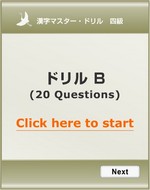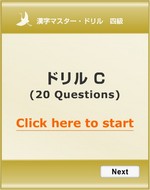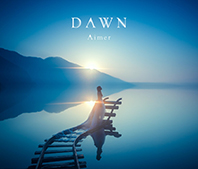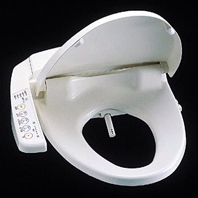Part 5: 休 食 飲 気 天 雨 春 夏 秋 冬
休 : キュウ、やす(まる)、やす(む)、やす(める)
Meaning: to rest
|
Click to see the stroke order animation.
| Word | Reading | Meaning | Class |
|---|---|---|---|
| 休む | やすむ | to rest, to have a break | v |
一時間休みましょう。 Let's take a rest for an hour. |
|||
| 休み | やすみ | day-off, holiday, break | n |
休みは何よう日ですか。 Which day is the day off? |
|||
食 : ショク、ジキ、く(う)、く(らう)、た(べる)
Meaning: to eat Shape: 人 + 良
|
| 食べる | たべる | to eat | v |
きのう、すし(寿司)を食べました。 I ate sushi yesterday. |
|||
| 食べ[物] | たべもの | food | n |
にほん(日本)の食べ物は、おいしいですか。 Is Japanese food delicious? |
|||
| 食[堂] | しょくどう | dining room | n |
食どうへ来てください。 Please come to the dining room. |
|||
飲 : イン、の(む)
Meaning: to drink Shape: 食 + 欠
|
| 飲む | のむ | to drink | v |
ビールを飲みませんか。 Why don't we drink beer? 今朝、くすりを飲みました。 I took the medicine this morning. |
|||
| 飲み[物] | のみもの | drink, beverage | n |
つめたい飲みものを、かい(買い)ました。 I bought cold drinks. |
|||
気 : キ、ケ
|
Meaning:
|
| [病]気 | びょうき | disease, illness, sickness | n |
かれは、先月からびょう気です。 He has been sick since last month. |
|||
| [元]気 | げんき | healthy, well, vigor | n, na-adj |
げん気をだして(出して)ください。 (Please) cheer up! |
|||
天 : テン、あま、あめ
Meaning: heaven, sky Shape: 一 + 大 Symbolizing higher area (一) above a person with unfurled arms (大).
|
| 天気 | てんき | weather | n |
今日は、天気がわるかった(悪かった)です。 The weather was bad today. |
|||
雨 : ウ、あま、あめ
|
Meaning: rain
|
| 雨 | あめ | rain | n |
夕方まで雨がふり(降り)ました。 It rained until evening. |
|||
春 : シュン、はる
Meaning: spring season
|
| 春 | はる | spring season | n |
春にさくら(桜)がさきます。 Cherry blossoms in spring. |
|||
夏 : カ、ゲ、なつ
|
Meaning: summer
|
| 夏 | なつ | summer | n |
きょ年の夏は、とてもあつかった(暑かった)です。 Summer last year was very hot. |
|||
| 夏休み | なつやすみ | summer vacation | n |
来年の夏休みにタイへ行きます。 I will go to Thailand during the summer vacation next year. |
|||
秋 : シュウ、あき
|
Meaning: autumn, fall Shape: 禾 + 火
|
| 秋 | あき | autumn, fall | n |
秋は、食べ物がおいしいです。 Foods are delicious in autumn. |
|||
冬 : トウ、ふゆ
|
Meaning: winter
|
| 冬 | ふゆ | winter | n |
今年の冬は、さむい(寒い)です。 Winter this year is cold. |
|||
Writing Practice
Printable writing practice sheet is available at Kanji Writing Practice page.
Tips for Beautiful Handwriting (1)
Differentiate straight and curved lines!
Kanji characters are mix of straight and curved lines. Look closely. Many lines are slightly curved, and that makes the character beautiful.
In most cases (but not all), horizontal and vertical lines are straight, and diagonal lines are curved.
Also in handwriting (especially in calligraphy), horizontal lines are slightly tilted upwards (beginning lower, ending higher).
Students of Western countries tend to write in Italic. It is not recommended to do it with Japanese characters.
 |
The line 1 & 2 are slightly curved. If you write it with two straight lines, it would look improper for native Japanese. |
|---|---|
 |
The line 1 & 2 are straight, 3 & 4 are slightly curved. The line 1 is slightly tilted upwards. |
























